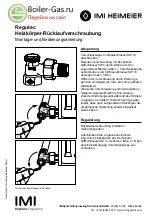
Part No. 5106463
23
litres
3.9
7.8
11.7
15.6
19.5
23.4
27.3
31.2
35.1
39.0
litres
25
50
75
100
125
150
175
200
225
250
Safety Valve Setting (bar)
Initial System Pressure (bar)
Total Water Content of System
3.0
1.0
1.5
VESSEL VOLUME (L)
For system volumes other than
those given above, multiply the
system volume by the factor
across
0.109
0.156
litres
2.7
5.4
8.2
10.9
13.6
16.3
19.1
21.8
24.5
27.2
0.5
0.0833
litres
2.1
4.2
6.3
8.3
10.4
12.5
14.6
16.7
18.7
20.8
Deduct from the value given in the table the 10 litre expansion vessel supplied.
Fig. 15
Table 6
The appliances incorporate a circulating pump, no
other pump is required. The appliances will operate
satisfactory on a two pipe small bore or micro bore
system using thermostatically controlled radiator
valves. When employing a central heating system
where primary water flow may be prevented during a
pump overrun situation (i.e. by using thermostatic
radiator valves on all radiators), a bypass valve should
be fitted between flow and return pipes.
It is strongly recommended that isolating valves are
fitted to the central heating flow and return pipes, this
will allow the boiler and heatstore tank (Fl ) to
be drained for service work without having to drain down
the whole central heating circuit.
On the Flowsure and Fl a drain point should
be provided in the domestic hot water pipework at any
point below the height of the domestic hot water heat
exchanger. Provision should also be made to allow air
to be vented from the domestic hot water pipework at
any high points.
Sealed Primary System
A manual reset overheat thermostat is located on the
underside of the electrical control panel and is
accessible by removing the boiler front casing panel. If
a boiler overheat condition arises the burner will remain
inoperative until the thermostat button is reset. See
the Users Instructions.
The pressure relief valve operates at 3 bar (45 lb/in²).
Install a pressure relief valve discharge pipe, not less
than 15 mm diameter and connect to the pressure relief
outlet connection using a 15 mm compression fitting.
The pipe run should be as short as possible, run
continuously downwards and discharge to the outside
of the building, where possible over a drain. The
discharge point must be such that it will not be
hazardous to occupants or cause damage to external
electrical components or wiring.
Note: It must not discharge above an entrance, or
window, or any type of public access. The installer
must consider that the overflow could discharge
boiling water. See Fig. 15.
The combined temperature /pressure gauge indicates
the system pressure, which must be maintained, and
the primary water temperature in the boiler shell.
The 10 litre expansion vessel is charged to 0.5 bar and
is suitable for a static head of 5 metres (16.5 ft), i.e. the
vertical distance between expansion vessel and highest
point of system, usually the top of bedroom radiators.
If the static head is greater than 5 metres, then the air
charge in the vessel must be increased to equal this
greater higher static pressure. The pressure can be
increased by simply pumping up the vessel with a
standard type pump and checking the pressure with a
tyre gauge. A schraider type valve is provided on the
vessel for this purpose. The air charge should not
exceed a pressure of 1.5 bar (22 p.s.i.).
With an initial system pressure of 0.5 bar, a system
capacity of about 120 litres (26.4 gals), can be
accommodated. A check should be made to ensure
the system volume comes within this capacity but if it
is greater, than an additional expansion vessel will be
needed. This should be fitted in ether the flow or return
pipes, as close as practicable to the boiler. Refer to BS
7074 Pt 1 for more information.
Note: The values given in Table 6 are the total system
volumes. The primary water capacity given in Table 2
should be deducted from the total system volume when
calculating the volume for the radiators, pipework etc.
Pre-Installation Requirements
















































